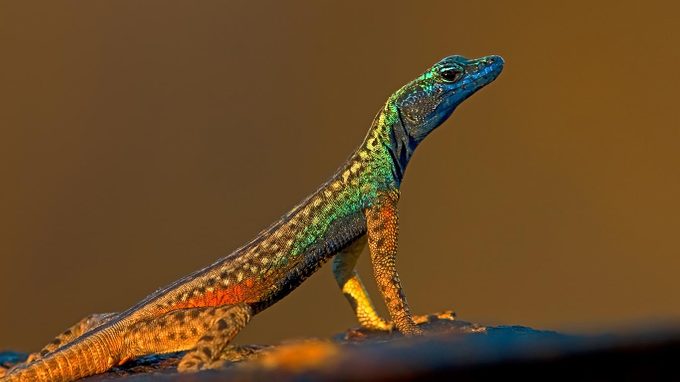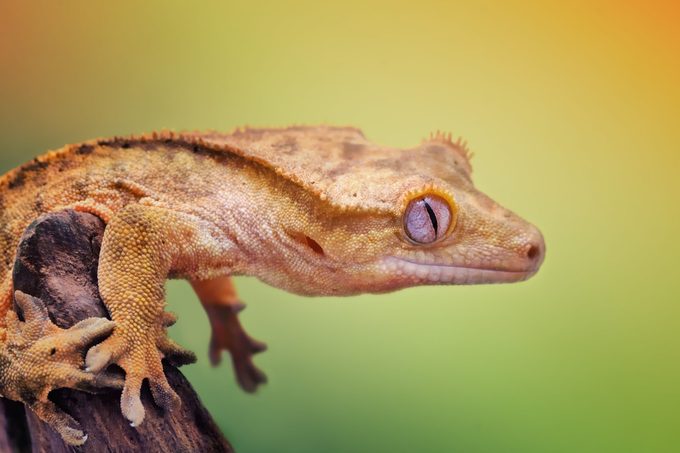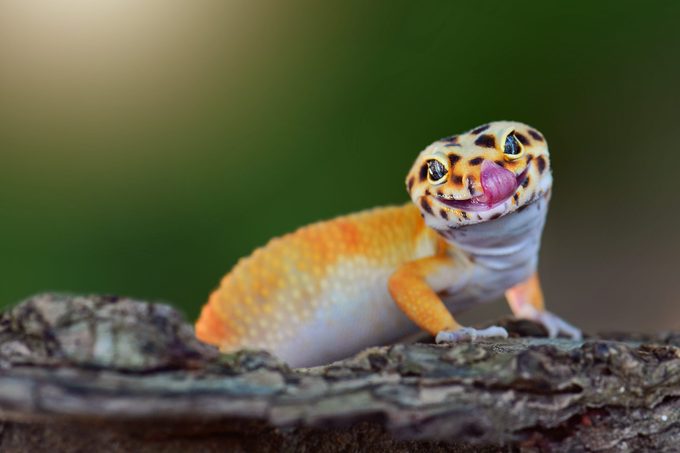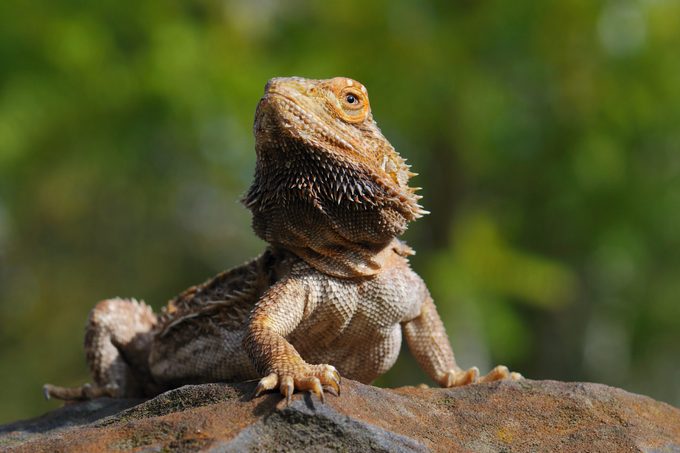Lizards live much longer in captivity than in the wild. How long do lizards live? We talk to an expert to find out.

How Long Do Lizards Live?

When you choose a lizard for a pet, you’re in it for the long haul. How long do lizards live? We’ll get to the specifics ahead, but know that many lizards live for a very long time. Your own pet’s lifespan will depend largely on how well you tend to its needs. And because lizards are often misunderstood, it’s important to learn all you can about these fascinating creatures.
So what should a good pet parent do to help a lizard live a long life? Reader’s Digest asked Ryan McVeigh, co-founder of VivTech, an organization that supports responsible reptile ownership, conservation, education and rescue efforts, to weigh in. Here’s what to know about taking care of your new lizard family member.
Get Reader’s Digest’s Read Up newsletter for more pets, cleaning, travel, tech and fun facts all week long.
How long do lizards live?
It depends on the kind of lizard, and where they live, but lizards can live anywhere from a few years to several decades. For the most part, lizards in captivity enjoy a longer life than lizards in the wild, especially if they have access to veterinary care and good nutrition. Captive lizards also don’t have to fend off predators, though cats and dogs should always be kept away from pet lizards. Like with any pet, proper care is the key to longevity.
What’s the most important part of caring for a lizard?
It’s definitely habitat. If you decide to make a lizard your new family member, he won’t live long if you just put him in a glass tank and toss in a few chirping crickets. Depending on the variety of lizard, you’ll need heat lamps, rocks, water, perches and other lizard-friendly habitat enhancers. And lizards, like other ectothermic (aka “cold-blooded”) animals, can’t regulate their body temperature internally, so they depend on you for help.
“They change the temperature of their body based on their environment, so creating a warm and cold side to the terrarium is imperative,” McVeigh says. Ultraviolet (UV) lighting is also critical—without it, lizards can’t make vitamin D, which they need to metabolize the calcium in their diet. Different species have different light requirements, so make sure you know exactly what your pet needs. Lizards who don’t get enough light will develop debilitating diseases, and could even die.
“While lizards are amazing pets, they do require more investment in their initial setup, and a good understanding of their care needs,” McVeigh says. “You need to know your lizard’s native habitat, since you need to recreate it at home.”
What are lizards like as pets?
If you’re used to cats and dogs, you may not know what to expect out of a pet lizard. Do they just sit around? Can you play with them? Are they fun? Well, McVeigh says you’re in for a surprise.
“Lizards are full of personality and really connect with their owner,” McVeigh says. “They learn the faces and voices of their owners and will often come to the front of the terrarium when they want food, or to get out and hang with their owner.” Lizards can even learn their names, and come to you on command!
What are the best lizards for beginners?
With so many exciting and cool-looking lizards to choose from, how can you possibly pick? Below, McVeigh walks us through four long-lived lizards for beginners, including two kinds of geckos, blue-tongued skinks and bearded dragons. “They are easy to care for, eat food that is easily accessible, aren’t too large and are fun to interact with.”
But even though these lizards are low-maintenance, it’s essential to prepare their housing before you bring them home. “The heating, lighting, nutrition and humidity must be correct in the terrarium before you put your new pet in it,” McVeigh says. Buying a lizard on impulse, without the correct environment already set up, will jeopardize its health.
Ready to get started? Here are four long-lived lizards for beginners.
Crested geckos

Crested geckos are low-maintenance pets that come in a variety of colors. They’re about 8 inches long from snout to tail, and they have a distinctive fringed crest that starts at their eyes and stretches down their back. How long do these lizards live? Crested geckos will be your companion for about 20 years, so it’s important to plan ahead before you bring one home.
Getting the right size terrarium is important for these geckos, as juveniles may get stressed out in a cage that’s too big. Temperature is also key; prolonged exposure to temperatures above 80 degrees can be fatal.
Blue-tongued skinks

As the name implies, this lizard has a long blue tongue that it uses to ward off predators. That’s not its only defense mechanism, either: If attacked, this cutie can leave its tail behind for a quick getaway. Blue-tongued skinks are about 18 to 24 inches long, and can live around 20 years. Before you come home with a pair of these lizards, know that they are very territorial, so each one needs its own home or they will fight.
Bearded dragons
Super friendly and docile, bearded dragons grow to between 12 and 24 inches and can happily live to 15 years when cared for properly. What’s that care look like? Bearded dragons need a weekly soak in lukewarm water, and exposure to UVB lighting. Like other lizards they can develop metabolic bone disease due to lack of calcium, resulting in deformations and premature death.
Leopard geckos

Look at that face! These little guys come in a variety of colors and are about 7 to 10 inches long. Leopard geckos live about 20 years, and they’re super chill and easy to handle. You can improve your leopard gecko’s health by adding a UVA/UVB light, which helps improve their immune system. And to ensure a healthy diet, you should spray your lizard’s insect meals with a calcium-boosting spray.
About the expert
|
Why trust us
At Reader’s Digest, we’re committed to producing high-quality content by writers with expertise and experience in their field in consultation with relevant, qualified experts. We rely on reputable primary sources, including government and professional organizations and academic institutions as well as our writers’ personal experiences where appropriate. We verify all facts and data, back them with credible sourcing and revisit them over time to ensure they remain accurate and up to date. Read more about our team, our contributors and our editorial policies.
Sources:
- Ryan McVeigh, co-founder of VivTech and founder of the Madison Area Herpetological Society (now Wisconsin Herpetological Association)
- VCA Animal Hospitals: “Lighting Requirements for Reptiles”
- Zilla: “Crested gecko”
- Zilla: “Blue Tongue Skink”
- Zilla: “Inland Bearded Dragon”
- Zilla: “Leopard Gecko”




















